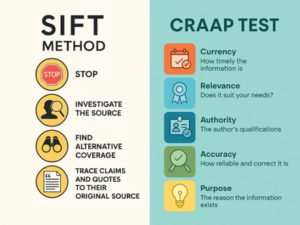Evaluating Source Credibility and Validity
- Jennifer Sutcliffe
- Published on 11/07/2025
- Updated on11/08/2025
Finding information online has never been easier—but not all of it is good. Finding accurate and credible information has never been more challenging due to the sheer volume of websites, articles, and other content that comes up in searches. Research platforms like JSTOR and EBSCOhost that you would find at a library have their own vetting processes for determining whether to include certain resources in their databases. The rest of the Internet, though, is chaotic and unfiltered. So, how do you go about evaluating information to determine if it’s responsible to use as a resource that supports your work?
Luckily, librarians and researchers have been thinking about these problems ever since the Internet became available to the general public. Experts have developed several methods that researchers can use to guide their process in evaluating sources. The methods discussed in this article all cover the essentials of evaluating information, and have acronyms that make them easy to remember: the SIFT Method and the CRAAP Test.

Each of these methods work toward a common goal: identifying misinformation (inaccurate information) and disinformation (intentional misrepresentation of facts) in sources. Citing sources containing misinformation and disinformation will reduce the credibility of your own work. Credibility means reliability or trustworthiness and speaks to the quality of the information, where it came from, and other factors related to its origins. Validity is a related concept and refers to the soundness of the process by which the conclusions presented in the source were obtained, such as research methods in an empirical study or the number of interviews and perspectives in a newspaper article.
SIFT Method
The SIFT method is a good starting place for getting down to the basics of evaluating article quality. Created by Mike Caulfield, a research scientist and consultant specializing in online media literacy, SIFT provides four essential thought processes for making sense of information on the Internet.
- Stop: When you come across a source, don’t immediately take it at face value. Sit with it for a moment and consider the information it contains.
- Investigate the Source: Look up what you can find about the person or organization who wrote the information to determine where it came from. Consider what biases they might bring to the work.
- Find Alternative Coverage: Do some research to see what else you can find about the topics covered in the source. Who else has written about it and how are they similar or different?
- Trace Claims and Quotes to their Original Source: Look for citations and references to other sources in the work and try to find where the information originally appeared. Pay attention to the authors and organizations associated with those works, the date they were published, and any potential conflicts of interest.
CRAAP Test
The CRAAP test was developed by California State University librarian Sarah Blakeslee and is intended to be a checklist of the different qualities to examine in a source. Methodically going through each of these items should reveal whether or not you should use it as a source.
- Currency: The year (and sometimes exact date) that the information was published is significant when considering whether a source is valid. A book from the 1960s that establishes an important theory may still be valid, but it should not be the only source cited on the topic in your paper because it doesn’t represent current information on that topic.
- Relevance: This aspect of a source relates to how it pertains to the project you’re working on. At this step, determine whether it will add important information that supports your approach to the topic, and whether it contains information at an appropriate level (e.g., beginner versus advanced knowledge).
- Authority: The qualifications and background of the author determine the authority of the work. If the individual lacks key credentials or experience, it indicates that the source may not have the necessary clout to support your work.
- Accuracy: There are several things that can help you assess how accurate the information in a source is. See if you can verify the information through other sources, including those cited in the source. Check the author’s methods and data to conclude whether they give sufficient evidence for their claims or if they might be selectively leaving out information.
- Purpose: Analyze the stated or plausible reasons why the author published the work. Try to identify whether it serves the purpose of informing, persuading, entertaining, or inciting specific action, and look out for places the author’s biases show up.
 |
The methods in these two frameworks can be used to help select the best sources to use for your writing when searching for information online. In addition to helping you avoid the pitfalls of misinformation and disinformation, they’re also generally useful for selecting the best resources for a specific purpose. For example, they can also be used as guides for choosing the sources from a library or database that best support the points you want to make. There is no one framework that’s better than another, so you can choose whichever resonates best with you or combine the methods as your needs require. |
GIVE YOUR CITATIONS A BOOST TODAY
Start your TypeCite Boost 3 day free trial today. Then just $4.99 per month to save your citations, organize in projects, and much more.
SIGN UP